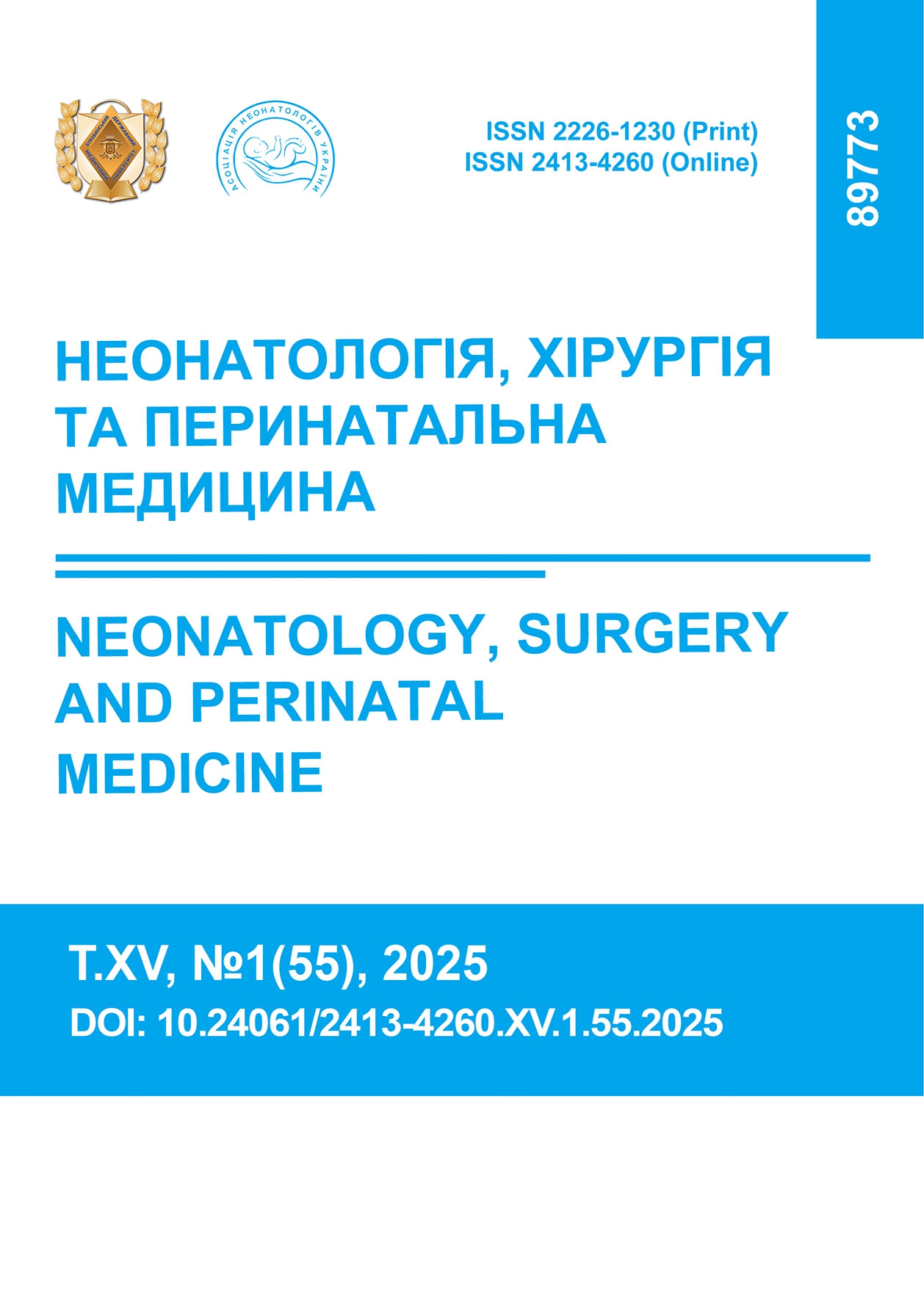БІОМАРКЕРИ В РАННІЙ ДІАГНОСТИЦІ ГОСТРОГО ПОШКОДЖЕННЯ НИРОК У ДІТЕЙ (ОГЛЯД ЛІТЕРАТУРИ)
DOI:
https://doi.org/10.24061/2413-4260.XV.1.55.2025.24Ключові слова:
гостре пошкодження нирок; біомаркери гострого пошкодження нирок; рання діагностика гострого пошкодження нирок; дітиАнотація
Діагностика гострого пошкодження нирок є одним з найактуальніших питань сучасної педіатрії. Класичним методом діагностики гострого пошкодження нирок залишається визначення рівня швидкості клубочкової фільтрації, креатиніну в сироватці крові та діурезу. В останні 10-15 років проводиться активний пошук і дослідження нових біомаркерів (БМ) гострого пошкодження нирок.
Мета дослідження. Розширити обізнаність лікарів-педіатрів стосовно можливостей використання біомаркерів в ранній діагностиці та своєчасному лікуванні гострого пошкодження нирок у дітей на основі аналізу сучасних літературних джерел.
Матеріали та методи дослідження. Проведено пошук сучасних літературних джерел на таких медичних порталах, як UpToDate, PubMed та інших, щодо використання біомаркерів у ранній діагностиці гострого пошкодження нирок серед педіатричних пацієнтів. Здійснено вивчення та аналіз отриманих даних.
Результати. У роботі наведено огляд сучасної літератури щодо можливостей використання біомаркерів гострого пошкодження нирок у дітей в ранній діагностиці цієї патології. Серед біомаркерів гострого пошкодження нирок виділені: креатинін, сечовина, ліпокалін, асоційований з нейтрофільною желатиназою (NGAL); цистатин С, фракційне виділення розчинених речовин (FeS), амоній (NH4)/аміак (NH3), інтерлейкін-18 (IL-18), молекула пошкодження нирок-1 (KIM-1), тканинний інгібітор металопротеїнази-2 (TIMP-2); білок 7, зв’язаний з інсуліноподібним фактором росту (IGFBP 7); білок печінкового типу, що зв'язує жирні кислоти (L-FABP); розчинний рецептор урокіназного активатора плазміногену (suPAR), Dickkopf 3 (DKK3), моноцитний хемотоксичний пептид-1 (MCP-1), епідермальний фактор росту (EGF), фактор росту фібробластів-23 (FGF-23), хемокіновий ліганд 14 (CCL14), хітіназа-3-подібний білок-1 (CHI3L1), уромодулін (білок Тамма-Хорсфолла) та α1 мікроглобулін (α1-M). Більшість цих біомаркерів гострого пошкодження нирок широко не використовується в повсякденній клінічній практиці та потребує подальшого вивчення, що обумовлює доцільність збільшення кількості досліджень у цьому напрямку.
Висновки. Викладені матеріали дозволять підвищити рівень обізнаності педіатрів та дитячих нефрологів про можливості використання сучасних біомаркерів гострого пошкодження нирок у дітей та розширити перспективи ранньої діагностики цієї патології, що забезпечить спроможність вчасно виявляти розвиток вказаного синдрому та розпочинати ефективне лікування.
Посилання
Gameiro J, Fonseca JA, Outerelo C, Lopes JA. Acute Kidney Injury: From Diagnosis to Prevention and Treatment Strategies. J Clin Med. 2020;9(6):1704. DOI: http://doi.org/10.3390/jcm9061704 PMID: 32498340; PMCID: PMC7357116.
Raina R, Chakraborty R, Tibrewal A, Sethi SK, Bunchman T. Advances in pediatric acute kidney injury. Pediatr Res. 2022;91(1):44-55. DOI: http://doi.org/10.1038/s41390-021-01452-3 PMID: 33731820.
Shaffer CL. The Use of Renal Biomarkers in Pediatric Cardiac Patients With Acute Kidney Injury. J Pediatr Pharmacol Ther. 2022;27(6):506-16. DOI: http://doi.org/10.5863/1551-6776-27.6.506 PMID: 36042964; PMCID: PMC9400178.
Mehta RL, Kellum JA, Shah SV, Molitoris BA, Ronco C, Warnock DG, et al. Acute Kidney Injury Network: report of an initiative to improve outcomes in acute kidney injury. Crit Care. 2007;11(2):R31. DOI: http://doi.org/10.1186/cc5713 PMID: 17331245; PMCID: PMC2206446.
Section 2: AKI Definition. Kidney Int Suppl (2011). 2012;2(1):19-36. DOI: http://doi.org/10.1038/kisup.2011.32 PMID: 25018918; PMCID: PMC4089595.
Frunza A. Hostre poshkodzhennia nyrok u peredchasno narodzhenykh ditei: perynatal'ni chynnyky ryzyku [Acute kidney injury in preterm neonates: perinatal risk factors]. Neonatolohiia, khirurhiia ta perynatal'na medytsyna. 2019;9(2(32):45-52. DOI: https://doi.org/10.24061/2413-4260.ix.2.32.2019.7 (In Ukrainian)
Hu Q, Li SJ, Chen QL, Chen H, Li Q, Wang M. Risk Factors for Acute Kidney Injury in Critically Ill Neonates: A Systematic Review and Meta-Analysis. Front Pediatr. 2021;9:666507. DOI: http://doi.org/10.3389/fped.2021.666507 PMID: 34336736; PMCID: PMC8316634.
Sethi SK, Bunchman T, Chakraborty R, Raina R. Pediatric acute kidney injury: new advances in the last decade. Kidney Res Clin Pract. 2021;40(1):40-51. DOI: http://doi.org/10.23876/j.krcp.20.074 PMID: 33663033; PMCID: PMC8041642.
van den Akker JP, Egal M, Groeneveld AB. Invasive mechanical ventilation as a risk factor for acute kidney injury in the critically ill: a systematic review and meta-analysis. Crit Care. 2013;17(3):R98. DOI: http://doi.org/10.1186/cc12743 PMID: 23710662; PMCID: PMC3706893.
Fan Y, Ye J, Qian L, Zhao R, Zhang N, Xue L, et al. Risk factors and outcomes of acute kidney injury in ventilated newborns. Ren Fail. 2019;41(1):995-1000. DOI: http://doi.org/10.1080/0886022X.2019.1665546 PMID: 31698978; PMCID: PMC6853215.
Bensman A. Non-steroidal Anti-inflammatory Drugs (NSAIDs) Systemic Use: The Risk of Renal Failure. Front Pediatr. 2020;7:517. DOI: http://doi.org/10.3389/fped.2019.00517 PMID: 32039104; PMCID: PMC6992590.
Morales-Alvarez MC. Nephrotoxicity of Antimicrobials and Antibiotics. Adv Chronic Kidney Dis. 2020;27(1):31-7. DOI: http://doi.org/10.1053/j.ackd.2019.08.001 PMID: 32146999.
Young J, Dahale D, Demmel K, O'Brien M, Geller J, Courter J, et al. Reducing acute kidney injury in pediatric oncology patients: An improvement project targeting nephrotoxic medications. Pediatr Blood Cancer. 2020;67(8):e28396. DOI: http://doi.org/10.1002/pbc.28396 PMID: 32495508.
Ciccia E, Devarajan P. Pediatric acute kidney injury: prevalence, impact and management challenges. Int J Nephrol Renovasc Dis. 2017;10:77-84. DOI: http://doi.org/10.2147/IJNRD.S103785 PMID: 28435306; PMCID: PMC5386613.
Luft FC. Biomarkers and predicting acute kidney injury. Acta Physiol. 2021;231(1):e13479. DOI: https://doi.org/10.1111/apha.13479
Younes-Ibrahim MS, Younes-Ibrahim M. Biomarkers and kidney diseases: a brief narrative review. J Lab Precis Med. 2022;7:20. DOI: https://doi.org/10.21037/jlpm-22-1
Fuhrman D. The use of diagnostic tools for pediatric AKI: applying the current evidence to the bedside. Pediatr Nephrol. 2021;36(11):3529-37. DOI: http://doi.org/10.1007/s00467-021-04940-0 PMID: 33492454; PMCID: PMC8813176.
Hanson HR, Carlisle MA, Bensman RS, Byczkowski T, Depinet H, Terrell TC, et al. Early prediction of pediatric acute kidney injury from the emergency department: A pilot study. Am J Emerg Med. 2021;40:138-44. DOI: http://doi.org/10.1016/j.ajem.2020.01.046 PMID: 32024590.
Lee YJ, Park YS, Park SJ, Jhang WK. Estimating baseline creatinine values to define acute kidney injury in critically ill pediatric patients. Kidney Res Clin Pract. 2022;41(3):322-31. DOI: http://doi.org/10.23876/j.krcp.21.120 PMID: 35172537; PMCID: PMC9184846.
Hasson D, Menon S, Gist KM. Improving acute kidney injury diagnostic precision using biomarkers. Pract Lab Med. 2022;30:e00272. DOI: http://doi.org/10.1016/j.plabm.2022.e00272 PMID: 35494424; PMCID: PMC9046880.
Frunza A, Hodovanets Yu. Renal dysfunction in preterm infants with perinatal pathology: risk factors, sensitivity and specificity of laboratory markers of damage. Neonatology, Surgery and Perinatal Medicine. 2024;1(4):30-40. DOI: https://doi.org/10.24061/2413-4260.XIV.1.51.2024.5
Kuo J, Akison LK, Chatfield MD, Trnka P, Moritz KM. Serum and urinary biomarkers to predict acute kidney injury in premature infants: a systematic review and meta-analysis of diagnostic accuracy. J Nephrol. 2022;35(8):2001-14. DOI: http://doi.org/10.1007/s40620-022-01307-y PMID: 35384606; PMCID: PMC9584850.
Harada T, Sorimachi H, Obokata M, Sunaga H, Ishida H, Ito K, et al. The relationship between antecedent creatinine decreases and outcomes in patients undergoing hemodialysis. Hemodial Int. 2020;24(1):89-98. DOI: http://doi.org/10.1111/hdi.12794 PMID: 31633866.
Shi Y, Duan H, Liu J, Shi X, Zhang Y, Zhang Q, et al. Blood urea nitrogen to serum albumin ratio is associated with all-cause mortality in patients with AKI: a cohort study. Front Nutr. 2024;11:1353956. DOI: http://doi.org/10.3389/fnut.2024 1353956. PMID: 38445205; PMCID: PMC10913022.
Patel ML, Shyam R, Bharti H, Sachan R, Gupta KK, Parihar A. Evaluation of Serum Cystatin C as an Early Biomarker of Acute Kidney Injury in Patients with Acute Pancreatitis. Indian J Crit Care Med. 2020;24(9):777-82. DOI: http://doi.org/10.5005/jp-journals-10071-23572 PMID: 33132559; PMCID: PMC7584843.
Hansson M, Gustafsson R, Jacquet C, Chebaane N, Satchell S, Thunberg T, et al. Cystatin C and α-1-Microglobulin Predict Severe Acute Kidney Injury in Patients with Hemorrhagic Fever with Renal Syndrome. Pathogens. 2020;9(8):666. DOI: http://doi.org/10.3390/pathogens9080666 PMID: 32824680; PMCID: PMC7460112.
Romejko K, Markowska M, Niemczyk S. The Review of Current Knowledge on Neutrophil Gelatinase-Associated Lipocalin (NGAL). Int J Mol Sci. 2023;24(13):10470. DOI: http://doi.org/10.3390/ijms241310470 PMID: 37445650; PMCID: PMC10341718.
Bazargani B, Moghtaderi M. New Biomarkers in Early Diagnosis of Acute Kidney Injury in Children. Avicenna J Med Biotechnol. 2022;14(4):264-9. PMID: 36504568; PMCID: PMC9706243.
Asaf S, Maqsood F, Jalil J, Sarfraz Z, Sarfraz A, Mustafa S, et al. Lipocalin 2-not only a biomarker: a study of current literature and systematic findings of ongoing clinical trials. Immunol Res. 2023;71(3):287-313. DOI: http://doi.org/10.1007/s12026-022-09352-2 PMID: 36529828; PMCID: PMC9760530.
Ganda IJ, Kasri Y, Susanti M, Hamzah F, Rauf S, Albar H, et al. Kidney injury molecule type-1, interleukin-18, and insulin-like growth factor binding protein 7 levels in urine to predict acute kidney injury in pediatric sepsis. Front Pediatr. 2022;10:1024713. DOI: http://doi.org/10.3389/fped.2022.1024713 PMID: 36545669; PMCID: PMC9760845.
Fazel M, Sarveazad A, Mohamed Ali K, Yousefifard M, Hosseini M. Accuracy of Urine Kidney Injury Molecule-1 in Predicting Acute Kidney Injury in Children; a Systematic Review and Meta-Analysis. Arch Acad Emerg Med. 2020;8(1):e44. PMID: 32309808; PMCID: PMC7159147.
Sun Q, Kang Z, Li Z, Xun M. Urinary NGAL, IGFBP-7, and TIMP-2: novel biomarkers to predict contrast medium-induced acute kidney injury in children. Ren Fail. 2022;44(1):1201-6. DOI: http://doi.org/10.1080/0886022X.2022.2075277 PMID: 36120960; PMCID: PMC9518296.
Huang Y, Huang S, Zhuo X, Lin M. Predictive value of suPAR in AKI: a systematic review and meta-analysis. Clin Exp Nephrol. 2023;27(1):1-11. DOI: http://doi.org/10.1007/s10157-022-02300-2 PMID: 36469196; PMCID: PMC9734903.
Hayek SS, Leaf DE, Samman Tahhan A, Raad M, Sharma S, Waikar SS, et al. Soluble Urokinase Receptor and Acute Kidney Injury. N Engl J Med. 2020;382(5):416-26. DOI: http://doi.org/10.1056/NEJMoa1911481 PMID: 31995687; PMCID: PMC7065830.
Rasmussen SR, Nielsen RV, Møgelvang R, Ostrowski SR, Ravn HB. Prognostic value of suPAR and hsCRP on acute kidney injury after cardiac surgery. BMC Nephrol. 2021;22(1):120. DOI: http://doi.org/10.1186/s12882-021-02322-0 PMID: 33827466; PMCID: PMC8025450.
Seibert FS, Heringhaus A, Pagonas N, Rohn B, Bauer F, Trappe HJ, et al. Dickkopf-3 in the prediction of contrast media induced acute kidney injury. J Nephrol. 2021;34(3):821-8. DOI: http://doi.org/10.1007/s40620-020-00910-1 PMID: 33275197; PMCID: PMC8192364.
Schunk SJ, Zarbock A, Meersch M, Küllmar M, Kellum JA, Schmit D, et al. Association between urinary dickkopf-3, acute kidney injury, and subsequent loss of kidney function in patients undergoing cardiac surgery: an observational cohort study. Lancet. 2019;394(10197):488-96. DOI: http://doi.org/10.1016/S0140-6736(19)30769-X PMID: 31202596.
Schunk SJ, Speer T, Petrakis I, Fliser D. Dickkopf 3-a novel biomarker of the 'kidney injury continuum'. Nephrol Dial Transplant. 2021;36(5):761-7. DOI: http://doi.org/10.1093/ndt/gfaa003 PMID: 32025732.
Köpfer F, Garbade SF, Klingbeil K, Schmidt-Mader B, Westhoff JH, Okun JG, et al. Kidney urinary biomarkers in patients with branched-chain amino acid and cobalamin metabolism defects. J Inherit Metab Dis. 2023;46(6):1078-88. DOI: http://doi.org/10.1002/jimd.12672 PMID: 37603032.
El-Absie HAM, Gaballah AM, El-Said HH, El-Deeb SA. NGAL , KIM-1, and MCP-1 as Biomarkers of Kidney Injury. Afr J Biol Sci. 2024;6(2):1150-61. DOI: https://doi.org/10.33472/AFJBS.6.2.2024.1150-1161
Sun S, Liu Z, Chen C, Wang Z, Jin H, Meng X, et al. Serum fibroblast growth factor 23 for early detection of acute kidney injury in critical illness. Am J Transl Res. 2021;13(11):12141-51. PMID: 34956442; PMCID: PMC8661170.
Tebib N, Monard C, Rimmelé T, Schneider A. Chemokine (C-C Motif) Ligand 14 to Predict Persistent Severe Acute Kidney Injury: A Systematic Review and Meta-Analysis. Blood Purif. 2024;53(11-12):860-70. DOI: http://doi.org/10.1159/000541058 PMID: 39182481.
Zeng J, Tao M, Sun H, Xu G. The emerging role of CHI3L1 as a diagnostic marker and therapeutic target in allergic diseases and respiratory comorbidities. Allergy Medicine. 2024; 1(100001). DOI: https://doi.org/10.1016/j.allmed.2024.100001
Aron AW, Amatruda JG. Fractional Excretion of Sodium and Urea are Useful Tools in the Evaluation of AKI: CON. Kidney360. 2023;4(6):e728-30. DOI: http://doi.org/10.34067/KID.0002512022 PMID: 37384888; PMCID: PMC10371370.
Lee YS, Choi YJ, Park KH, Park BS, Son JM, Park JY, et al. Liver Transplant Patients with High Levels of Preoperative Serum Ammonia Are at Increased Risk for Postoperative Acute Kidney Injury: A Retrospective Study. J Clin Med. 2020;9(6):1629. DOI: http://doi.org/10.3390/jcm9061629 PMID: 32481585; PMCID: PMC7356740.
Nusshag C, Theobald V, Wortmann M, Kaimann P, Dietrich M, Gruneberg D, et al. Biomarker-guided detection of acute kidney injury in abdominal aortic surgery: the new and the old. Front Med (Lausanne). 2024;11:1386018. DOI: http://doi.org/10.3389/fmed.2024.1386018 PMID: 39021823; PMCID: PMC11251966.
You R, Zheng H, Xu L, Ma T, Chen G, Xia P, et al. Decreased urinary uromodulin is potentially associated with acute kidney injury: a systematic review and meta-analysis. J Intensive Care. 2021;9(1):70. DOI: http://doi.org/10.1186/s40560-021-00584-2 PMID: 34782019; PMCID: PMC8591828.
Będzichowska A, Jobs K, Kloc M, Bujnowska A, Kalicki B. The Assessment of the Usefulness of Selected Markers in the Diagnosis of Chronic Kidney Disease in Children. Biomark Insights. 2021;16:11772719211011173. DOI: http://doi.org/10.1177/11772719211011173 PMID: 33958853; PMCID: PMC8060753.
##submission.downloads##
Опубліковано
Як цитувати
Номер
Розділ
Ліцензія

Ця робота ліцензується відповідно до Creative Commons Attribution 4.0 International License.
Автори, які публікуються у цьому журналі, погоджуються з наступними умовами:
- Автори залишають за собою право на авторство своєї роботи та передають журналу право першої публікації цієї роботи на умовах ліцензії Creative Commons Attribution License, котра дозволяє іншим особам вільно розповсюджувати опубліковану роботу з обов'язковим посиланням на авторів оригінальної роботи та першу публікацію роботи у цьому журналі.
- Автори мають право укладати самостійні додаткові угоди щодо неексклюзивного розповсюдження роботи у тому вигляді, в якому вона була опублікована цим журналом (наприклад, розміщувати роботу в електронному сховищі установи або публікувати у складі монографії), за умови збереження посилання на першу публікацію роботи у цьому журналі.
- Політика журналу дозволяє і заохочує розміщення авторами в мережі Інтернет (наприклад, у сховищах установ або на особистих веб-сайтах) рукопису роботи, як до подання цього рукопису до редакції, так і під час його редакційного опрацювання, оскільки це сприяє виникненню продуктивної наукової дискусії та позитивно позначається на оперативності та динаміці цитування опублікованої роботи (див. The Effect of Open Access).
Критерії авторського права, форми участі та авторства
Кожен автор повинен був взяти участь в роботі, щоб взяти на себе відповідальність за відповідні частини змісту статті. Один або кілька авторів повинні нести відповідальність в цілому за поданий для публікації матеріал - від моменту подачі до публікації статті. Авторитарний кредит повинен грунтуватися на наступному:
- істотність частини вклада в концепцію і дизайн, отри-мання даних або в аналіз і інтерпретацію результатів дослідження;
- написання статті або критичний розгляд важливості її інтелектуального змісту;
- остаточне твердження версії статті для публікації.
Автори також повинні підтвердити, що рукопис є дійсним викладенням матеріалів роботи і що ні цей рукопис, ні інші, які мають по суті аналогічний контент під їх авторством, не були опубліковані та не розглядаються для публікації в інших виданнях.
Автори рукописів, що повідомляють вихідні дані або систематичні огляди, повинні надавати доступ до заяви даних щонайменше від одного автора, частіше основного. Якщо потрібно, автори повинні бути готові надати дані і повинні бути готові в повній мірі співпрацювати в отриманні та наданні даних, на підставі яких проводиться оцінка та рецензування рукописи редактором / членами редколегії журналу.
Роль відповідального учасника.
Основний автор (або призначений відповідальний автор) буде виступати від імені всіх співавторів статті в якості основного кореспондента при листуванні з редакцією під час процесу її подання та розгляду. Якщо рукопис буде прийнята, відповідальний автор перегляне відредагований машинописний текст і зауваження рецензентів, прийме остаточне рішення щодо корекції і можливості публікації представленої рукописи в засобах масової інформації, федеральних агентствах і базах даних. Він також буде ідентифікований як відповідальний автор в опублікованій статті. Відповідальний автор несе відповідальність за подтверждленіе остаточного варіанта рукопису. Відповідальний автор несе також відповідальність за те, щоб інформація про конфлікти інтересів, була точною, актуальною і відповідала даним, наданим кожним співавтором.Відповідальний автор повинен підписати форму авторства, що підтверджує, що всі особи, які внесли істотний внесок, ідентифіковані як автори і що отримано письмовий дозвіл від кожного учасника щодо публікації представленої рукописи.
















